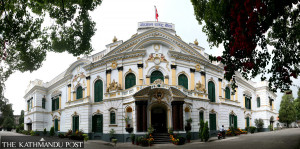Columns
Historical account of bird migration
The earliest of this puzzlement dates back to the time of the Greek polymath Aristotle.
Anuj Ghimire
A flock of Black-headed gulls, a bird that breeds way up North, reached Kathmandu valley last week. Thousands of birds from over 150 species call Nepal home or use it as a stopover site during the winter migration season. The migration of Demoiselle crane and Bar-headed geese, which takes them above the mighty Himalayas, has puzzled many scientists and naturalists. Sir Edmund Hilary, in his book High Adventure, mentions observing birds above Mount Everest during the ascent towards the summit.
Every spring, billions of birds flock together to make their annual journey towards their northern breeding grounds. They spend roughly 3-4 months making the arduous journey back to their wintering grounds. This brilliant spectacle of our feathered friends is known as bird migration. Over the last few decades, studies of bird migration from around the world have revealed why, how, and when these birds migrate. However, a little less than 100 years ago, scientists were puzzled by the concept of birds migrating thousands of kilometres.
The earliest of this puzzlement goes back to the time of the Greek philosopher and polymath Aristotle. One of the solutions that Aristotle put forward was that the birds transformed into a different species in winter, and with the onset of spring, they’d go back to being birds! Fast forward 1,500 years or so, and people were still speculating that birds hibernate during the winter, just like amphibians do. The earliest prediction hinting at a longer tiring migration in birds came from Charles Morton, who suggested that birds migrated to the moon during winter and came back to Earth in spring.
One fortunate evening for Ornithology and a sad evening for a White stork in 1822 in a small town in Germany changed the course of understanding in what birds do during winter. A white stork was shot in that German village; it was a special stork with a wooden spear impaled through its neck. That spear came from African wood, suggesting that the bird had been somewhere in Africa. The first authentic proof that birds indeed migrate to the south during winter.
In 1899, Hans Mortensen banded European Starlings with metal rings to track their movements, thereby scientifically starting the process of bird banding. This marked the final piece of the puzzle in understanding whether or not birds migrated.
Around 42 years later, in the war-ridden United Kingdom, two biologists stationed at a camp tasked with observing radar to intercept enemy fighter planes kept seeing mysterious signals on the radar. They’d signal the camp, mistaking it for an enemy vessel; however, it would dissipate in no time. As it continued for a while, they figured out a solution to identify these unknown threats, which they had named “Angels” or “Ghosts”. The simple solution was to observe the sky with a telescope whenever they had a radar signal. Fortune enough for science, those ended up being birds!
By the mid-1900s, bird migration was a fact; however, scientists were still unfolding the truth behind how or why birds migrate.
Some scientists had suggested that birds migrate at night, which stirred up the conversation in the avian science world, as others rejected that birds would migrate at night rather than during broad daylight when they can see things clearly. The only way to prove this was to observe them at night during peak migration season. That’s exactly what George Lowery, an ornithologist based in Louisiana, did. In 1880, William Scott reported seeing migrating birds silhouetted against the moon while he was looking at it through a telescope. Using the same technique, Lowery observed the night sky from Yucatan and saw that birds do migrate at night and through the Gulf coast rather than following the land route.
In 1957, ornithologist Richard Graber and engineer Bill Cochran collaborated to record nocturnal bird calls using a bicycle axle and 6,000 feet of record tape. Almost 80 percent of migratory birds are known to fly during the nighttime, and birds have specific nocturnal flight calls. By 1965, Richard Graber was using a radio transmitter to track Grey-cheeked Thrushes in Illinois. Sadly, during those times, the transmitter could only transmit to a receiver, so you had to be close to the bird to know where it was. For Graber, it meant he was on a small plane, holding out an antenna, trying to find a bird in the middle of the night over Lake Michigan. Bill ended up following another thrush over 930 miles to Manitoba, Canada, in the next few years.
By 1970, Robert Fleming Jr, Tim and Carol Inskipp were observing diurnal raptor migrations in various parts of Central Nepal. On November 2, 1976, Flemming Jr counted 305 Steppe Eagles in about an hour close to the Dhampus ridge. On November 7, 1970, the Inskipps and their colleagues reported a south-westerly movement of various raptors from the Daman area, including 174 Steppe eagles. The steppe eagle is one of the birds that migrates from east to west, rather than the north-south migration of many species of birds.
By 1984, the Argos satellite system was used to track larger birds, such as swans and eagles. With the selective availability of GPS systems to the public by the year 2000, bird migration studies started to pick up. The year 2002 marked the start of the biggest citizen science programme ever created. Named ‘eBird’, it is an online database of birds from all over the world. People can log all the birds they’ve seen or heard for the rest of the world to see. Currently, eBird has over 112 million checklists submitted by 1.15 million users worldwide.
Understanding what birds do, what they can do, during migration was still in its infancy when a Bar-tailed Godwit named E-7 broke the world record for being a bird that travelled 7,000 miles nonstop from Alaska to New Zealand. Later in 2022, B6, just a four-month-old Bar-tailed Godwit, broke E-7’s record when he migrated 8425 miles (13,560km) nonstop. A group of scientists started a project to keep track of migrating birds named “BirdCast”, which uses weather radar technology to predict migrating birds.
Birds migrate in such huge flocks that they create a giant cloud that shows up on weather radar. For ages, meteorologists have disregarded them as mere noise. Now, BirdCast can predict the species of birds, the number of birds, and the direction they’re heading based on their movement pattern and weather conditions.




 18.12°C Kathmandu
18.12°C Kathmandu















